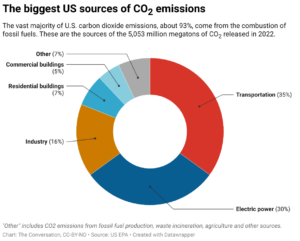Changes In The Earth’s Climate Are Making Food Production More Costly – CleanTechnica

Report on the Impact of Extreme Weather on Food Prices and Sustainable Development
Introduction: The Nexus of Climate Change, Food Prices, and Global Goals
A study published in Environmental Letters on July 21, 2025, establishes a direct link between extreme weather events and rising global food prices. This phenomenon poses a significant threat to the achievement of the Sustainable Development Goals (SDGs), particularly SDG 2 (Zero Hunger) and SDG 1 (No Poverty), by increasing food insecurity and economic hardship for vulnerable populations. The resulting inflation carries substantial economic and political ramifications, challenging global stability and progress toward sustainable development.
Global Impact of Climate Extremes on Food Inflation
Evidence from Recent Climate-Driven Price Spikes
The research highlights several recent instances where extreme weather has directly caused significant increases in food commodity prices. These events underscore the tangible consequences of failing to meet the objectives of SDG 13 (Climate Action).
- In Arizona and California, extreme heat and drought during the summer of 2022 led to an 80% increase in the price of locally grown vegetables by the end of that year.
- A prolonged drought in Spain and Italy from 2022 to 2023 resulted in a 50% rise in olive oil prices by 2024.
- Extreme weather in the Ivory Coast and Ghana contributed to a tripling of cocoa prices.
- Similar conditions led to a doubling of some coffee prices in the past year.
Economic and Societal Ramifications
The study builds on previous research conducted with the European Central Bank, which found that abnormally high temperatures drive increases in food prices and overall inflation. This trend complicates the efforts of central banks to maintain economic stability, directly impacting SDG 8 (Decent Work and Economic Growth). Maximillian Kotz, the study’s lead author, warns that future climate change will intensify these heat-related price increases, leading to a cascade of negative social, economic, and nutritional consequences.
Implications for Sustainable Development Goals (SDGs)
Threats to SDG 2 (Zero Hunger) and SDG 3 (Good Health and Well-being)
Rising food prices disproportionately affect low-income and food-insecure households, forcing them to alter their consumption patterns in ways that undermine health and nutrition. Research from the Food Foundation in London demonstrates that when prices increase, these households reduce their consumption of fruits and vegetables. This trend exacerbates health disparities and presents a significant obstacle to achieving SDG 3 (Good Health and Well-being), as access to nutritious food is critical for immunity and protection against chronic diseases.
Impact on SDG 16 (Peace, Justice and Strong Institutions)
History provides stark examples of how climate-related food price shocks can fuel social unrest and political instability, undermining SDG 16. Raj Patel of the International Panel of Experts on Sustainable Food Systems notes that wildfires in Russia in 2010 caused wheat prices to skyrocket, a factor that contributed to the Arab Spring protests. In a separate event, the subsequent Russian wheat export embargo led to bread riots in Mozambique, where police response resulted in civilian deaths. These incidents illustrate how localized climate events can trigger global price volatility with fatal consequences, destabilizing societies and eroding peace.
Setbacks for SDG 10 (Reduced Inequalities) and SDG 5 (Gender Equality)
Recent policy changes within the United States Department of Agriculture (USDA) further compound the challenge of inequality. The termination of programs designed to assist socially disadvantaged farmers represents a direct reversal of efforts to achieve SDG 10 (Reduced Inequalities). The policy change affects key groups that have faced historical barriers to resources and credit.
- Black farmers
- Women farmers
- Veteran farmers
This move, which has led to the cancellation of 145 grants worth $148.6 million for Black farmers, is described by critics like Congresswoman Shontel Brown as part of a “resegregation agenda” that dismantles tools for leveling the playing field. By eliminating support structures for women in agriculture, the policy also constitutes a setback for SDG 5 (Gender Equality). The resulting uncertainty for farmers is projected to lead to higher consumer prices and increased debt for agricultural producers.
Conclusion: An Urgent Call for Integrated Action
The evidence demonstrates that climate change is a critical driver of economic instability, social inequality, and political unrest, primarily through its impact on the global food system. These interconnected crises actively undermine progress on a wide range of Sustainable Development Goals, including SDG 1, SDG 2, SDG 3, SDG 5, SDG 8, SDG 10, SDG 13, and SDG 16. The growing threat of food insecurity risks deepening divisions between nations and communities at a time when collective action is most critical, challenging the fundamental SDG principle to “leave no one behind.”
1. Which SDGs are addressed or connected to the issues highlighted in the article?
-
SDG 2: Zero Hunger
- The article’s central theme is the impact of extreme weather on food prices, which directly affects food security and access to nutritious food. It discusses how price spikes lead to food insecurity and changes in consumption, particularly for low-income households.
-
SDG 13: Climate Action
- The article explicitly links “extreme weather,” “abnormally high temperatures,” and “drought” to the rise in food prices. It frames the issue as a direct consequence of climate change, highlighting the need to address climate-related hazards.
-
SDG 10: Reduced Inequalities
- The article details the termination of USDA programs designed to assist “Black farmers, women, and veterans.” It discusses how these policies reverse efforts to level the playing field for “socially disadvantaged” groups and perpetuate historical inequalities.
-
SDG 1: No Poverty
- Rising food prices disproportionately affect the poor and vulnerable, pushing them further into poverty. The article mentions how food-insecure households, often those with the lowest incomes, are forced to make difficult choices, impacting their well-being.
-
SDG 5: Gender Equality
- The article specifically mentions the termination of programs that supported women farmers and notes the hurdles they face compared to their male counterparts. This directly relates to empowering women and ensuring their equal access to economic resources in agriculture.
-
SDG 16: Peace, Justice and Strong Institutions
- The article connects food price spikes to social unrest and violence, citing the examples of the Arab Spring and “bread riots” in Mozambique that led to deaths. It also discusses discriminatory policy actions by government institutions (USDA), which undermines justice and strong, equitable governance.
-
SDG 3: Good Health and Well-being
- The article points out that when food prices rise, “food-insecure households in the UK reduce their consumption of fruits and vegetables.” This has direct health consequences, as these foods are “massively important for immunity, but also long term protections from a whole range of chronic conditions.”
2. What specific targets under those SDGs can be identified based on the article’s content?
-
Target 2.1: End hunger and ensure access to safe, nutritious food
- The article highlights how price increases for essential goods like vegetables and olive oil make it difficult for people, especially low-income households, to access sufficient and nutritious food, leading to food insecurity.
-
Target 2.c: Adopt measures to ensure the proper functioning of food commodity markets
- The article provides an example of market failure where Russia “imposed an embargo on wheat exports, sending the global price of wheat soaring.” This demonstrates the negative impact of market disruptions on global food prices and stability.
-
Target 13.1: Strengthen resilience and adaptive capacity to climate-related hazards
- The entire premise of the study cited in the article is that societies are not resilient to climate-related hazards like “extreme heat and dry soil conditions,” which are shown to directly cause food price shocks and inflation.
-
Target 10.2: Empower and promote the social, economic and political inclusion of all, irrespective of race, sex, etc.
- The article describes the USDA’s cancellation of programs for “Black farmers, women, and veterans” as a “deliberate and disgraceful step backward” that actively works against the inclusion of these groups in the agricultural economy.
-
Target 5.a: Give women equal rights to economic resources, including access to and control over land and financial services
- The termination of USDA programs that favored women farmers is a direct reversal of policies aimed at providing them with better access to economic resources and opportunities in agriculture, a field where the article notes they face unique hurdles.
-
Target 16.1: Significantly reduce all forms of violence and related death rates
- The article links food price spikes directly to violence, referencing how higher wheat prices contributed to the “Arab Spring anti-government protests and violence” and how bread riots in Mozambique led to police opening “fire with live ammunition,” causing deaths.
3. Are there any indicators mentioned or implied in the article that can be used to measure progress towards the identified targets?
-
Indicator of food price anomalies (Relates to Target 2.c)
- The article provides several specific data points that serve as indicators of price anomalies: “an 80% increase in the price of vegetables,” “a 50% increase in olive oil prices,” “a tripling of prices of cocoa,” and “a doubling of some coffee prices.” It also refers more broadly to “consumer price indexes” and “inflation.”
-
Prevalence of food insecurity (Relates to Target 2.1)
- The article implies this indicator by discussing “food-insecure households” and how their behavior changes when prices rise. The research by the Food Foundation in London, which found that these households reduce fruit and vegetable consumption, is a measure of the impact of food insecurity.
-
Financial flows and support for marginalized groups (Relates to Targets 10.2 and 5.a)
- A clear, quantifiable indicator is mentioned: the cancellation of “145 grants worth $148.6 million that were promised to Black farmers.” This figure directly measures the reduction of financial support aimed at reducing inequality.
-
Number of deaths and protests related to social unrest (Relates to Target 16.1)
- The article implies these indicators by citing historical events. The mention of “bread riots,” “anti-government protests and violence,” and “deaths by live ammunition” in Mozambique suggests that tracking such incidents can measure the link between food insecurity and social instability.
4. Table of SDGs, Targets, and Indicators
| SDGs | Targets | Indicators |
|---|---|---|
| SDG 2: Zero Hunger | 2.1: End hunger and ensure access to safe, nutritious food.
2.c: Adopt measures to ensure the proper functioning of food commodity markets. |
Prevalence of food insecurity (implied by reduced consumption of fruits/vegetables by food-insecure households).
Indicator of food price anomalies (e.g., “80% increase in the price of vegetables,” “50% increase in olive oil prices”). |
| SDG 13: Climate Action | 13.1: Strengthen resilience and adaptive capacity to climate-related hazards. | Frequency and impact of extreme weather events on food production (e.g., “extreme heat and dry soil conditions” leading to price spikes). |
| SDG 10: Reduced Inequalities | 10.2: Empower and promote the social, economic and political inclusion of all, irrespective of race, etc. | Financial flows directed to marginalized groups (e.g., cancellation of “$148.6 million” in grants for Black farmers). |
| SDG 5: Gender Equality | 5.a: Give women equal rights to economic resources. | Existence and funding of programs to support women farmers (e.g., termination of USDA programs that favored women). |
| SDG 16: Peace, Justice and Strong Institutions | 16.1: Significantly reduce all forms of violence and related death rates. | Number of protests, riots, and deaths related to food price increases (e.g., “bread riots” in Mozambique, “Arab Spring” violence). |
| SDG 3: Good Health and Well-being | (Implied) Ensure healthy lives and promote well-being. | Consumption of nutritious food like fruits and vegetables, particularly by low-income households. |
Source: cleantechnica.com

What is Your Reaction?
 Like
0
Like
0
 Dislike
0
Dislike
0
 Love
0
Love
0
 Funny
0
Funny
0
 Angry
0
Angry
0
 Sad
0
Sad
0
 Wow
0
Wow
0











































































